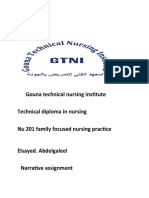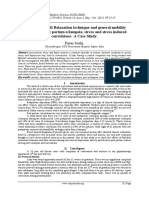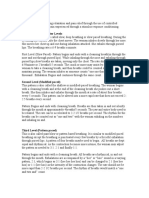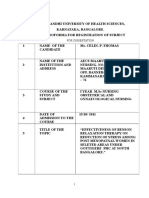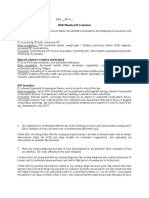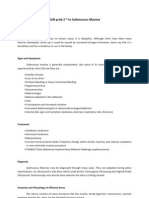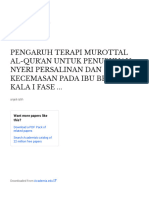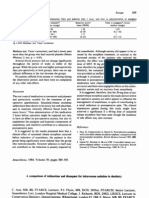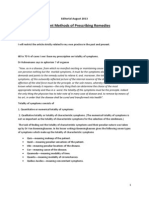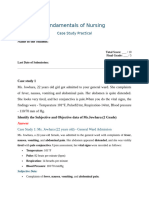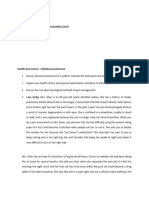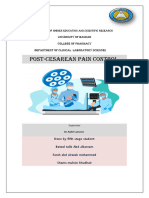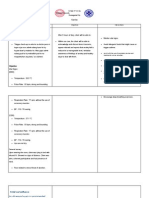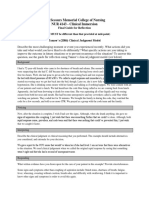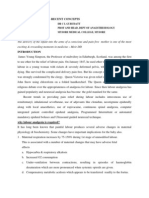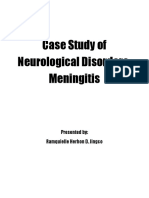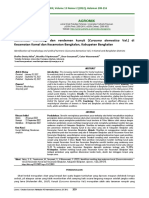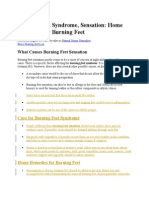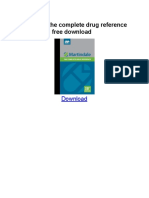Mrs Brown Case Study
Mrs Brown Case Study
Uploaded by
jessturtleCopyright:
Available Formats
Mrs Brown Case Study
Mrs Brown Case Study
Uploaded by
jessturtleCopyright
Available Formats
Share this document
Did you find this document useful?
Is this content inappropriate?
Copyright:
Available Formats
Mrs Brown Case Study
Mrs Brown Case Study
Uploaded by
jessturtleCopyright:
Available Formats
Nursing and Health Breakdown Assessment 2: Case Study (Skill Analysis) Part A I undertook ABCDE assessment of Mrs Cheryl
Brown on her return to the ward after her laparoscopic appendectomy (NSW Health, 2009). After introducing myself to Mrs Brown I asked her how her day was going and how she was feeling. She was able to reply that she has pain (1) on a scale of 1-10 and nausea. I looked for accessory muscle movement and intercostal recession and bilateral chest and abdominal wall movement that would indicate difficulty in the airways. During Mrs Browns replies I listened to her speech and for gurgling, stridor and noisy respiration which would indicate an abnormality within airways. Mrs Cheryl Brown was conscious and talking as she replied to my questions. I checked for central cyanosis which would indicate lack of oxygen. I also listened for abnormal breathing noises and percussed the chest wall to determine healthy sound. I then took Mrs Browns respiratory rate for a whole minute, keeping in mind she has had morphine which is a respiratory depressant and can lower respiratory rate. The normal adult respiratory rate is 12-20 breaths per a minute, Mrs Browns was 12 respirations per a minute which is the lower end of normal. I also took her oxygen saturation levels which are 96% on room air. I then conferred to supervisor as to whether oxygen therapy should be advised as the normal oxygen saturation level (according to the DETECT manual) should be greater than or equal to 97% (NSW Health, 2009). I checked Mrs Browns skin for pallor and peripheral cyanosis. I listened for confusion in speech and chest complaints. I then felt for warm hands and feet, also checked rhythm and rate of pulse for 30 seconds which can indicate possible concerns for circulation if the pulse
is thready, erratic or unusual. I then applied fingertip pressure to Mrs Browns hand at heart level for five seconds than released to check for capillary refill which should be less than 2 seconds. The normal adult temperature is 36.1 37.8 degrees Celsius, Mrs Browns is 36.5 degrees Celsius which is normal. The normal adult heart rate is 60-100 beats per a minute, Mrss Browns is 80 beats per a minute which is normal. The normal blood pressure is 140/90mmHg to 90/60mmHg, Mrs Browns blood pressure is 105/60 mmHg which is normal. Then, checking for disabilities or neurological negative effects, I observed Mrs Brown for facial muscle symmetry during her replies to my questions. I then checked for abnormal movements, seizure activity, slurred speech and inability to move muscles. Using a medical pen light I then checked Mrs Browns pupillary light reflex. After this I performed a Glasgow Coma Scale Assessment of Mrs Brown to ascertain her neurological stability (Stroke Society of Australasia, 2009). I then checked Mrs Brown gently but thoroughly for any bruises, contusions or wounds not resultant of the procedure. I also examined bags, drains and bottles for signs of blood or abnormal fluids. I also noted skin turgor and central venous pressure. She has a wound expected from the operation and routine inspection of colour, size and disinfection of the wound is required. Positioning of Mrs Brown is important so she does not put pressure on the wound. Part B Two nursing interventions undertaken as a result of Mrs Browns ABCDE assessment include sitting her upright and oxygen therapy. Mrs Brown has indicated she has been feeling nauseous; she could vomit which would compromise her airways and breathing and consequently circulation. I would sit Mrs Brown in an upright position with a container in
case she does vomit for if she was lying down and vomited, gravity would impede process and vomit could become trapped in airways and impede respiration. I also have ensured routine supervision to check her airways and breathing is unobstructed. Mrs Brown also has the pharmacological intervention of metoclopramide hydrochloride (Maxolon) 10 mg IM injection which is to be reviewed in an hour. Maxolon should hopefully aid with nausea which is most likely a result of the morphine from the operation. This will decrease likelihood of vomiting and compromising airways. However Maxolon does have side effects and comes with the warning that it can influence the effect of other drugs such as morphine (Kamerman, Becker, & Fick, 2007). So after safely administering this medicine I would routinely check and ask Mrs Brown how much pain she is in on a scale of one to ten. I would also utilise the Glasgow Coma Scale to ensure disabilities do not develop (Stroke Society of Australasia, 2009). The second nursing intervention employed is oxygen therapy. Morphine is a respiratory depressant, this can affect respiration, breathing and consequently, oxygen saturation levels (Cancer Council Queensland, 2008). Mrs Browns saturation levels returned a reading of 96% which is slightly lower then preferred. It is advised in many nursing textbooks to aim for an oxygen saturation of 97% or higher in patients. After conferring with my supervisor I would utilise oxygen therapy to ensure Mrs Browns oxygen saturation levels increase which will aid with healing and nausea. Sitting Mrs Brown up in this nursing intervention would also aid to relieve pressure on respiratory muscles, allowing easier breathing.
References Cancer Council Queensland (2008, October). Understanding Morphine. Home - Cancer Council Queensland. Retrieved September 2012, from http://www.cancerqld.org.au/icms_docs/60347_Wanem_Morphine_TSI_Creole.pdf Kamerman, P. R., Becker, N., & Fick, L. G. (2007). Interactions between metoclopramide and morphine: enhanced antinociception and motor dysfunction in rats. Clinical and Experimental Pharmacology and Physiology, 34(1-2), 106. NSW Health (2009). Between the Flags. Keeping Patients Safe [Web log post]. Retrieved from http://nswhealth.moodle.com.au/DOH/DETECT/content/index.htm Stroke Society of Australasia (2009, January 10). The Glasgow Coma Scale. Stroke Society of Australasia. Retrieved September 2012, from http://www.strokesociety.com.au/index.php?option=com_content&view=article&id=289
You might also like
- BRITISH GESTALT JOURNAL Volume 22, No. 2, November 2013Document67 pagesBRITISH GESTALT JOURNAL Volume 22, No. 2, November 2013Irena SimicNo ratings yet
- Marquez - Case Study 3Document6 pagesMarquez - Case Study 3Caren MarquezNo ratings yet
- Close Your MouthDocument144 pagesClose Your MouthSelvakumaran Dhandapani100% (13)
- RPNDocument21 pagesRPNAruna Teja Chennareddy50% (8)
- Case Simulation 123 IjcgDocument3 pagesCase Simulation 123 IjcgIrish Jane GalloNo ratings yet
- DR Robert J Rowen-Gentlest Most Effective Pain Relief EverDocument4 pagesDR Robert J Rowen-Gentlest Most Effective Pain Relief Evermr_sparkleNo ratings yet
- Gouna Technical Nursing Institute Technical Diploma in Nursing Nu 201 Family Focused Nursing PracticeDocument5 pagesGouna Technical Nursing Institute Technical Diploma in Nursing Nu 201 Family Focused Nursing PracticeElsayed MohamedNo ratings yet
- Doris Bowman VsimDocument10 pagesDoris Bowman Vsimlunamoongames120No ratings yet
- DischargeplanningDocument6 pagesDischargeplanningapi-288858560No ratings yet
- E01022327 PDFDocument5 pagesE01022327 PDFNanang Diyaz100% (1)
- Mid Point Reflection For ImmersionDocument2 pagesMid Point Reflection For Immersionapi-431939757No ratings yet
- Lamaze Breathing Patter LevelsDocument4 pagesLamaze Breathing Patter Levelsezyl twotownNo ratings yet
- For DissertationDocument13 pagesFor DissertationRegi viniciyaNo ratings yet
- For DissertationDocument13 pagesFor DissertationRegi viniciyaNo ratings yet
- LNYGDocument22 pagesLNYGgyanlydiananayaaNo ratings yet
- Blog David Beales 31.12.2022 Breathe Jsmile and Be PresentDocument5 pagesBlog David Beales 31.12.2022 Breathe Jsmile and Be Presentdbeales126No ratings yet
- Updated Writing Case Notes With SamplesDocument16 pagesUpdated Writing Case Notes With Samplessunil wesley100% (8)
- LEARNING ACTIVITY 2 For RLE A Person With Acute Respiratory AcidosisDocument3 pagesLEARNING ACTIVITY 2 For RLE A Person With Acute Respiratory AcidosisHope SerquiñaNo ratings yet
- Funda 1Document19 pagesFunda 1Ronald De CastroNo ratings yet
- wk4 Weekly Self Eval KmiuraDocument3 pageswk4 Weekly Self Eval Kmiuraapi-295640482No ratings yet
- Clinical ExemplarDocument3 pagesClinical Exemplarapi-283672381No ratings yet
- Research MethodsDocument6 pagesResearch MethodsDesmond Grasie ZumankyereNo ratings yet
- Case Study MyomaDocument18 pagesCase Study MyomaAgnes Nadine J. FraginalNo ratings yet
- Management of Primary Dysmenorrhoea by Dry Cupping: A ReviewDocument5 pagesManagement of Primary Dysmenorrhoea by Dry Cupping: A ReviewWilyanto YangNo ratings yet
- 98 177 1 SM20191030 46080 1ku8m98 With Cover PageDocument16 pages98 177 1 SM20191030 46080 1ku8m98 With Cover PageWildan MalikiNo ratings yet
- A Comparison of Midazolam and Diazepam For Intravenous Sedation in DentistryDocument5 pagesA Comparison of Midazolam and Diazepam For Intravenous Sedation in DentistryGu GuuNo ratings yet
- EndometriosisDocument4 pagesEndometriosislokesh_arya1No ratings yet
- 2013-08 Editorial For The Month of August 2013 (Different Methods of Prescribing Remedies)Document6 pages2013-08 Editorial For The Month of August 2013 (Different Methods of Prescribing Remedies)sunnyjamielNo ratings yet
- Task 1 Study The Patient Care Plant Below, Then Report To The Other ParticipantsDocument6 pagesTask 1 Study The Patient Care Plant Below, Then Report To The Other ParticipantsRiri DondoNo ratings yet
- Pain Management During Labor & Second Stage of LaborDocument97 pagesPain Management During Labor & Second Stage of LaborTheMothershipNo ratings yet
- Acute Care Final Reflective Journal 2018 - Jamie BorelDocument4 pagesAcute Care Final Reflective Journal 2018 - Jamie Borelapi-431213859No ratings yet
- Case Study 115Document6 pagesCase Study 115Jonah MaasinNo ratings yet
- Fundamentals of Nursing Case Study Practical IIDocument7 pagesFundamentals of Nursing Case Study Practical IIahmed7778258No ratings yet
- Knodeweek 8 Ans 2 PDocument3 pagesKnodeweek 8 Ans 2 Papi-278552800No ratings yet
- Nakaweesi Maria Health AssessmentDocument4 pagesNakaweesi Maria Health AssessmentMaria NakaweesiNo ratings yet
- ReflectionDocument2 pagesReflectionapi-283689862No ratings yet
- Case Simu 115Document5 pagesCase Simu 115Princess Levie CenizaNo ratings yet
- How Orthomolecular Medicine Can Help: Contributed by Dr. Abram HofferDocument11 pagesHow Orthomolecular Medicine Can Help: Contributed by Dr. Abram HofferWilliam AckermannNo ratings yet
- Case Simu 123Document6 pagesCase Simu 123Princess Levie CenizaNo ratings yet
- 1249Post-cesarean pain controlDocument17 pages1249Post-cesarean pain controlsamarkamal384No ratings yet
- CASE STUDY Labor and DeliveryDocument2 pagesCASE STUDY Labor and DeliveryAprodite Sumod-ong100% (1)
- Introduction Chapter 1-2Document29 pagesIntroduction Chapter 1-2FarahNo ratings yet
- Wang 2009Document8 pagesWang 2009Graziele GuimarãesNo ratings yet
- Dr. Pankaj NaramDocument12 pagesDr. Pankaj NaramGiovanni Villarino100% (1)
- BookmarksDocument8 pagesBookmarksRonNo ratings yet
- Danger Signs During Labor and Delivery and Pain Relief During ChildbirthDocument4 pagesDanger Signs During Labor and Delivery and Pain Relief During ChildbirthKaye Niale BaleteNo ratings yet
- Clinical ExemplarDocument4 pagesClinical Exemplarapi-316161401No ratings yet
- Labor and Delivery QuizDocument7 pagesLabor and Delivery QuizAmy50% (2)
- Hypnosis HealsDocument61 pagesHypnosis HealsJeanette Perez100% (1)
- Case Study Uterine MyomaDocument30 pagesCase Study Uterine MyomaNikko Dela Cruz100% (1)
- Kardex2 Doc3456789Document14 pagesKardex2 Doc3456789markyabresNo ratings yet
- Non-Pharmacologic Pain Management During Labor-1-1-1Document21 pagesNon-Pharmacologic Pain Management During Labor-1-1-1azminabulsyNo ratings yet
- Final Reflection EvaluationDocument2 pagesFinal Reflection Evaluationapi-456149894No ratings yet
- Labour Analgesia - Recent ConceptsDocument18 pagesLabour Analgesia - Recent ConceptsSuresh KumarNo ratings yet
- Cure Sleep Apnea - Everything About Sleep Apnea And Sleep Apnea TreatmentFrom EverandCure Sleep Apnea - Everything About Sleep Apnea And Sleep Apnea TreatmentRating: 3.5 out of 5 stars3.5/5 (3)
- Principles of Healing Through Movement: An Alternative Holistic Approach to Therapeutic Movement for those with Cancer and/or Chronic IllnessFrom EverandPrinciples of Healing Through Movement: An Alternative Holistic Approach to Therapeutic Movement for those with Cancer and/or Chronic IllnessNo ratings yet
- Muscle Tension Dysphonia, A Simple Guide To The Condition, Diagnosis, Treatment And Related ConditionsFrom EverandMuscle Tension Dysphonia, A Simple Guide To The Condition, Diagnosis, Treatment And Related ConditionsNo ratings yet
- Some Quality Control Analysis Parameters For Parenteral FormulationsDocument5 pagesSome Quality Control Analysis Parameters For Parenteral FormulationsEditor IJTSRDNo ratings yet
- Case Study of Neurological DisordersDocument10 pagesCase Study of Neurological DisordersSkyerexNo ratings yet
- 2883-Document Text-10917-1-10-20221019Document8 pages2883-Document Text-10917-1-10-20221019As'ad Atqia ArhamiNo ratings yet
- How To Use Derma Stamp Pen LatestDocument12 pagesHow To Use Derma Stamp Pen LatestParis AdriánNo ratings yet
- Antibiotic Sensitivity ChartDocument1 pageAntibiotic Sensitivity ChartFerdinand von HebraNo ratings yet
- Burning Feet SyndromeDocument4 pagesBurning Feet SyndromeSellappan MuthusamyNo ratings yet
- Glioma - Chinh SuaDocument176 pagesGlioma - Chinh SuaHikari AoiNo ratings yet
- Finished Prod 1Document11 pagesFinished Prod 1Ashok KumarNo ratings yet
- TRÍPTICODocument2 pagesTRÍPTICOroh van0% (1)
- DIC Algorithm PDFDocument3 pagesDIC Algorithm PDFRico Novyanto100% (1)
- Martindale The Complete Drug Reference 38th Edition Free Download PDFDocument3 pagesMartindale The Complete Drug Reference 38th Edition Free Download PDFChristian SosaNo ratings yet
- 64 Vital Nerve CentresDocument29 pages64 Vital Nerve CentresadinaNo ratings yet
- Forensic Notes PDFDocument155 pagesForensic Notes PDFSoni Mahendran100% (3)
- Reflexes in The GutDocument2 pagesReflexes in The GutJeffrey TseNo ratings yet
- Training Manual - Housekepping - WTTCDocument20 pagesTraining Manual - Housekepping - WTTCGpm Gerakan Pemuda MushollaNo ratings yet
- Legal Duties of Doctor in PoisoningDocument9 pagesLegal Duties of Doctor in PoisoningToshal WankhadeNo ratings yet
- LPL - Lpl-Rohini (National Reference Lab) Sector - 18, Block - E Rohini DELHI 110085Document1 pageLPL - Lpl-Rohini (National Reference Lab) Sector - 18, Block - E Rohini DELHI 110085Vinothkumar VKNo ratings yet
- ASCOHER2BC20Document66 pagesASCOHER2BC20Mihary RamanandraitsioryNo ratings yet
- Officers Board of Directors: Anne Arundel County Maryland Ostomy Association, Inc. P.O. BOX 847 Gambrills, MD 21054Document8 pagesOfficers Board of Directors: Anne Arundel County Maryland Ostomy Association, Inc. P.O. BOX 847 Gambrills, MD 21054janicewinters7760No ratings yet
- PHARMACOLOGYDocument44 pagesPHARMACOLOGYshruti sangwan100% (1)
- Patient SatisfactionDocument2 pagesPatient SatisfactionanushavergheseNo ratings yet
- Biochem Lab Finals Rev PDFDocument2 pagesBiochem Lab Finals Rev PDFMigs BernalNo ratings yet
- Medical Rehabilitation in Compression FractureDocument32 pagesMedical Rehabilitation in Compression FracturegloriaNo ratings yet
- NCP Micu Hascvd Cad - RioDocument5 pagesNCP Micu Hascvd Cad - RioRio BonifacioNo ratings yet
- GC2006 00 Part1 2 3Document378 pagesGC2006 00 Part1 2 3mysian100% (1)
- Blue Royale 0 65 BrochureDocument12 pagesBlue Royale 0 65 BrochureAna Patricia SanchezNo ratings yet
- Generic Skin Care Questionnaire 1Document2 pagesGeneric Skin Care Questionnaire 1João Pedro AraújoNo ratings yet
- Eng 172 Essay FinishedDocument4 pagesEng 172 Essay Finishedapi-276026601No ratings yet
- Propolis MouthrinseDocument9 pagesPropolis MouthrinseRobins DhakalNo ratings yet






